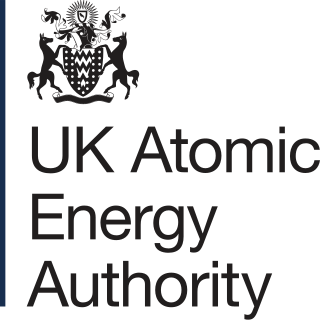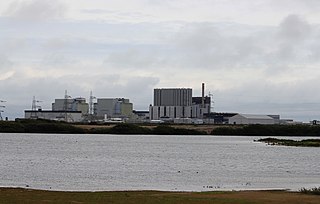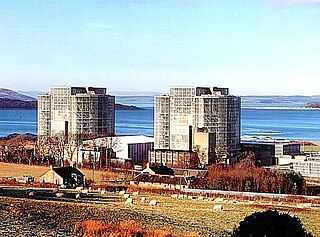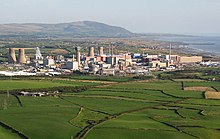
Sellafield, formerly known as Windscale, is a large multi-function nuclear site close to Seascale on the coast of Cumbria, England. As of August 2022, primary activities are nuclear waste processing and storage and nuclear decommissioning. Former activities included nuclear power generation from 1956 to 2003, and nuclear fuel reprocessing from 1952 to 2022.

Magnox is a type of nuclear power / production reactor that was designed to run on natural uranium with graphite as the moderator and carbon dioxide gas as the heat exchange coolant. It belongs to the wider class of gas-cooled reactors. The name comes from the magnesium-aluminium alloy, used to clad the fuel rods inside the reactor. Like most other "Generation I nuclear reactors", the Magnox was designed with the dual purpose of producing electrical power and plutonium-239 for the nascent nuclear weapons programme in Britain. The name refers specifically to the United Kingdom design but is sometimes used generically to refer to any similar reactor.

Great British Nuclear, officially British Nuclear Fuels Ltd is a nuclear energy and fuels company owned by the UK Government. It is a non-departmental public body sponsored by the Department for Energy Security and Net Zero.

The United Kingdom Atomic Energy Authority is a UK government research organisation responsible for the development of fusion energy. It is an executive non-departmental public body of the Department for Energy Security and Net Zero (DESNZ).

The Dungeness nuclear power stations are a pair of non-operational nuclear power stations located on the Dungeness headland in the south of Kent, England.

Dounreay is a small settlement and the site of two large nuclear establishments on the north coast of Caithness in the Highland area of Scotland. It is on the A836 road nine miles west of Thurso.

Chapelcross nuclear power station is a former Magnox nuclear power station undergoing decommissioning. It is located in Annan in Dumfries and Galloway in southwest Scotland, and was in operation from 1959 to 2004. It was the sister plant to the Calder Hall nuclear power station plant in Cumbria, England; both were commissioned and originally operated by the United Kingdom Atomic Energy Authority. The primary purpose of both plants was to produce weapons-grade plutonium for the UK's nuclear weapons programme, but they also generated electrical power for the National Grid. Later in the reactors' lifecycle, as the UK slowed the development of the nuclear deterrent as the cold war came to a close, power production became the primary goal of reactor operation.

Wylfa nuclear power station is a Magnox nuclear power station undergoing decommissioning. Wylfa is situated west of Cemaes Bay on the island of Anglesey, off the northwestern coast of Wales. Construction of the two 490 MW nuclear reactors, known as Reactor 1 and Reactor 2, began in 1963. They became operational in 1971. Wylfa was located on the coast because seawater was used as a coolant.
Sellafield Ltd is a British nuclear decommissioning Site Licence Company (SLC) controlled by the Nuclear Decommissioning Authority (NDA), a UK government body set up specifically to deal with the nuclear legacy under the Energy Act 2004. From 2008–2016, it was operated under licence from the NDA by a third party Parent Body Organisation called Nuclear Management Partners (NMP). Since the termination of the NMP contract it has been brought back under direct governmental control by making it a subsidiary of the NDA.

The Thermal Oxide Reprocessing Plant, or THORP, is a nuclear fuel reprocessing plant at Sellafield in Cumbria, England. THORP is owned by the Nuclear Decommissioning Authority and operated by Sellafield Ltd.
Nuclear power in the United Kingdom generated 16.1% of the country's electricity in 2020. As of August 2022, the UK has 9 operational nuclear reactors at five locations, producing 5.9 GWe. It also has nuclear reprocessing plants at Sellafield and the Tails Management Facility (TMF) operated by Urenco in Capenhurst.
Nuclear decommissioning is the process leading to the irreversible complete or partial closure of a nuclear facility, usually a nuclear reactor, with the ultimate aim at termination of the operating licence. The process usually runs according to a decommissioning plan, including the whole or partial dismantling and decontamination of the facility, ideally resulting in restoration of the environment up to greenfield status. The decommissioning plan is fulfilled when the approved end state of the facility has been reached.

The Low Level Waste Repository is the UK's central long-term store for low-level radioactive waste located on the West Cumbrian coast near Drigg village and opened in 1959. It is a subsidiary of the Nuclear Decommissioning Authority.

Hunterston A nuclear power station is a former Magnox nuclear power station located at Hunterston in Ayrshire, Scotland, adjacent to Hunterston B. The ongoing decommissioning process is being managed by Nuclear Decommissioning Authority (NDA) subsidiary Magnox Ltd.
The National Nuclear Laboratory is a UK government owned and operated nuclear services technology provider covering the whole of the nuclear fuel cycle. It is fully customer-funded and operates at six locations in the United Kingdom. Its customers have included the Nuclear Decommissioning Authority, Sellafield Ltd, Westinghouse, the Health and Safety Executive, the Ministry of Defence, the UK Atomic Energy Authority, VT Nuclear and British Energy. It also has links with academia, including collaborative agreements on waste immobilisation and disposal with the University of Sheffield and on nuclear materials research with the University of Manchester.

Trawsfynydd nuclear power station is a former Magnox nuclear power station situated in Snowdonia National Park in Gwynedd, Wales. The plant, which became operational in 1965, was the only nuclear power station in the UK to be built inland, with cooling water that was taken from the artificial Llyn Trawsfynydd reservoir which also supplies the hydro-electric Maentwrog power station. It was closed in 1991. Its ongoing decommissioning by Magnox Ltd was expected to take almost 100 years, but in 2021 the Welsh government arranged for the power station to be redeveloped using small-scale reactors.

Magnox Ltd, currently trading as Nuclear Restoration Services, is a wholly-owned subsidiary of the Nuclear Decommissioning Authority (NDA), responsible for the safe decommissioning of British nuclear sites. Originally created for the management of Magnox nuclear reactors, it went through various forms of organisation throughout privatisation of the nuclear industry, until coming into NDA ownership in 2019. It rebranded to NRS in October 2023.

International Nuclear Services (INS) is a United Kingdom company involved in the management and transport of nuclear fuels. INS is based near Whitehaven, in Cumbria and is operated by Nuclear Transport Solutions, a wholly owned subsidiary of the UK Government's Nuclear Decommissioning Authority (NDA).

Nucleus, the Nuclear and Caithness Archives is the national archive of the British civil nuclear industry and the archive for the County of Caithness. The archives were constructed by the Nuclear Decommissioning Authority (NDA) and opened in 2017. Work continues at the facility to bring together all of the NDA's archive material from 16 separate sites. The Caithness county archives, dating from 1589 are also held at the site.

Dorothy Anne Gradden OBE is a British Nuclear Engineer for Sellafield Ltd. She leads the projects to decommission the large "legacy" ponds. These are nationally important projects as part of country's nuclear clean up operation on "Britain’s biggest and most hazardous nuclear waste site". In 2017 she was given an OBE and in 2019 the Nuclear Decommissioning Authority recognised her as a role model in their Safety and Wellbeing Awards.

















